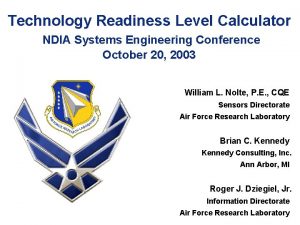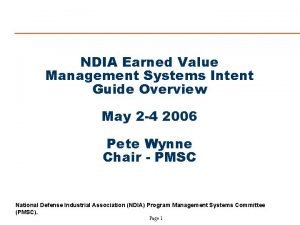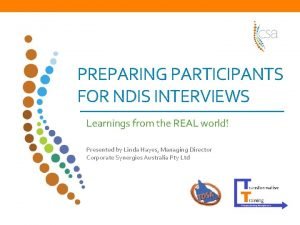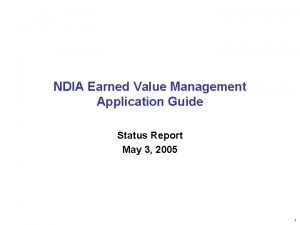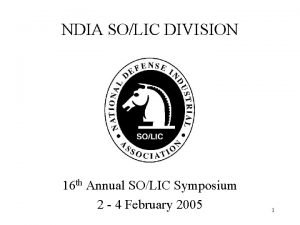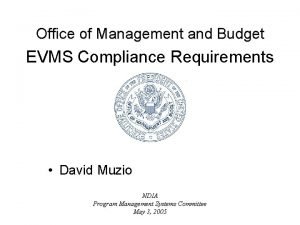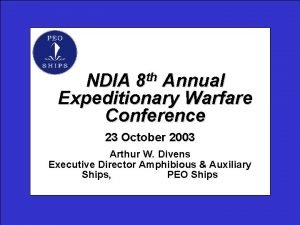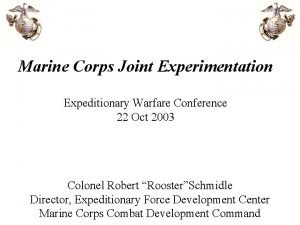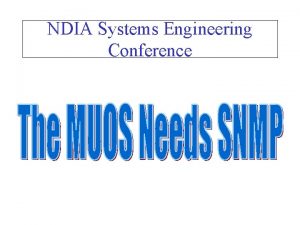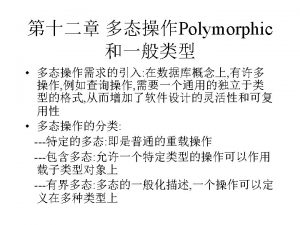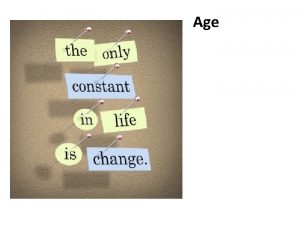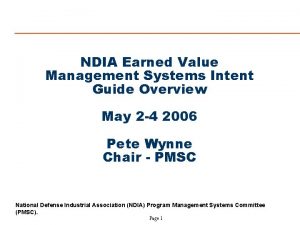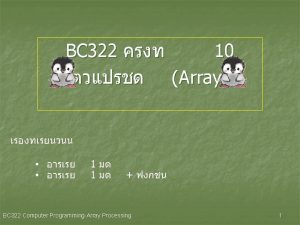Data Management in the Digital Age NDIA Systems




















- Slides: 20

Data Management in the Digital Age NDIA Systems Engineering Conference San Diego, California – October 2003 Cynthia C. Hauer Millennium Data Management, Incorporated Huntsville, Alabama

AGENDA n n n Looking back Framing the issues Elements of the solution Cause and effect Panacea versus process The way forward Challenges, Questions, and Solutions

DM Definition Data management is the structured processes and systems that plan for, acquire, and maintain data, consistent with requirements, throughout the data life cycle. EIA-Standard-859 (Draft)

Data Management Functions n Identification/Definition • Data Requirements, Life cycle Needs n Preparation • Internal and External Data n Control • • • n Document control processes Import/Export of data IP, proprietary, limited access User authorizations, use requests Master Lists Data Marking Changes are required in the approach range, and the methods for the DM functions Dispositioning • DMP • Delivery (digital or physical) n Archival • Project files, decision data, data retention

Looking back n n DM was mandated in the 1960’s by Congress and the Do. D Original intent • Eliminate redundancy of data production and storage • Centralize systems use • Acquire only specific data for deliberate, planned, and specified use Strategic Planning, Continuing Goals, Increased Urgency

Background n DM evolved out of Do. D and Congressional concerns (circa 1960) • • • $$$ being spent on technical data and no one knew how much Available $ was not being spent effectively Much of what was being acquired was unnecessary, redundant, and obsolete • DM was an expensive resource that was not being managed wisely • Finally – no one knew what was being purchased, ordered, or used, anyway n Industry complaints increased re: the number and variety of management systems being imposed on them in development and production contracts • Data was pushing up the cost of contracts r Perception was that Do. D was attempting to increase and maintain control of contracts by requiring even more information • And no one knew what the originally acquired data really was, what it supported, and what anyone was doing with it n Perception: the necessity for some of the management systems and the supporting data was questionable and unclear • Some elements required and acquired the same things in different ways • Some Do. D systems required generation of data that was already available in the contractor’s own internal data systems So What Has Changed?

The problem is more pressing n n n More data than ever Less money than before Business model revolution Best practices rule Transaction and decision time is compressed Network centric strategies And “technology” is not the solution

Changing Environment Business Relationships Vertical Integration………………………. . . Trust-Based Relationships Design Responsibility Do. D Design Bureaus……………………. …. . Industry Design Teams Standards Development & Implementation Mil-Specs, Mil-Stds……………. ……. . . ………………. . Commercial Standards Acquisition Cycle 12 - 15 years……………. . . ……………………… 2 - 5 years 1950 Computer Systems Development Cycle 2000+ NA………………………………. 18 - 24 Months Weapon System Life Cycle 20 years………………………. . 50+ years Commercial Systems Life Cycle 10 - 15 years…………………………. 2 - 5 Years Logistics Support DLA, Do. D Depots & IMAs…………. . Mix of Government and Contractor Logistics Support Transaction-based…………. . …………………………. . Performance-based

Yesteryear’s Environment Build it in accordance with the government design Weapon System Acquisition Process ABC, Inc. SOW System-Spec Mil-Specs Mil-Stds Data Storage and Transfer System Design Do. D Inspector CM Manager/ QA Auditor. Tradesman Data Manager

Yesteryear’s Environment, cont. Weapon System Acquisition Process Weapon System 12 - 15 year development cycle Data Environment: Paper-based Site A Data ? = Site B Data ? = Site C Data

Today’s Environment ABC, Inc XYZ Co. Build a system that can meet these KPPs. Weapon System Acquisition Process R&E, Inc System Design Virtual Co. , Inc. ABC, Inc. SOO KPP 1 KPP 2 KPP 3 KPP 4 2 - 5 year development cycle Digital Data Environment Web Access

Data Management “Solution”: Three Primary Areas - Principles, Practices, and Training Principles Practices • Basic tenets • Implementation and values • General specifics • Organization-specific Training Basic and Advanced (PM and Practitioner)

Data Management “Solution: ” continued Three Primary Areas - Principles, Practices, and Training Principles • Basic tenets and values • General Practices EIA 859 Templates Training Basic and Advanced (PM and Practitioner) • Implementation specifics • Some are organizationalspecific

Data Management “Solution, ” continued Three Primary Areas - Principles, Practices, and Training Practices Principles • Basic tenets and values • General EIA 859 Templates Do. D 5010. 12 -M Do. D 4140. 1 -R Industry implementation guides FAR DFARS Service-specific instructions UDEF and EIA 927, EIA 836 • Implementation specifics • Some are organizationalspecific • Partially obsolete • Partially in conflict • Missing elements • Potential solutions Training Basic and Advanced (PM and Practitioner)

Data Management “Solution, ” continued Three Primary Areas - Principles, Practices, and Training Practices Principles • Basic tenets and values • General EIA 859 Templates Do. D 5010. 12 -M Do. D 4140. 1 -R Industry implementation guides FAR DFARS Service-specific instructions UDEF and EIA 927, EIA 836 Key Practices Best Practices Career Field (DAU) Colleges and Universities Training Basic and Advanced (PM and Practitioner) • Implementation specifics • Some are organization- specific

Data Management “Solution, ” continued Three Primary Areas - Principles, Practices, and Training Practices Principles • Basic tenets and values • General EIA 859 Templates Do. D 5010. 12 -M Do. D 4140. 1 -R Industry implementation guides FAR DFARS Service-specific instructions UDEF and EIA 927, EIA 836 Key Practices Best Practices • Implementation specifics • Some are organizationspecific TBD Training Basic and Advanced (PM and Practitioner) Complete solution addresses all three areas

Structuring outcomes n n n Addressing challenges Identifying disconnects Creating solutions Establishing relationships Crafting an accepted and valueadded role Building credibility and acceptance Strategic Data Management

The way forward n n Process first! then automation Sequencing the “push/pull” correctly Creating intentional, understood outcomes Strategic thinking • Enterprise focus

Challenges for the DM Practice n Consistency • Expectations and practice n Communication • Internal and external n Training • Practitioners and other disciplines n …

Summary n n DM goals, need, and requirements are the same as they were in 1960 Urgency to transition DM to the digital environment is increased Recognized pathway and importance for resolution EIA-Standard-859 is the beginning 4 th Quarter of CY 2003 Release
 Afrl trl calculator
Afrl trl calculator Iron age bronze age stone age timeline
Iron age bronze age stone age timeline Iron age bronze age stone age timeline
Iron age bronze age stone age timeline Earned value management systems eia-748-c intent guide
Earned value management systems eia-748-c intent guide Ndia evms application guide
Ndia evms application guide Introduction
Introduction Ndia interview
Ndia interview Ndia evms application guide
Ndia evms application guide Ndia solic
Ndia solic Ndia solic
Ndia solic Ndia evms
Ndia evms Ndia expeditionary warfare conference
Ndia expeditionary warfare conference Expeditionary warfare conference
Expeditionary warfare conference Ndia electronics division
Ndia electronics division Digital data digital signals
Digital data digital signals Data encoding and modulation
Data encoding and modulation Digital encoding schemes
Digital encoding schemes Management information systems managing the digital firm
Management information systems managing the digital firm Premature adrenarche
Premature adrenarche Victorian age and modern age
Victorian age and modern age Paleolithic age vs neolithic age
Paleolithic age vs neolithic age
